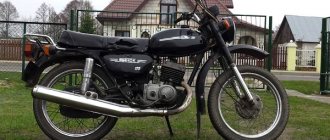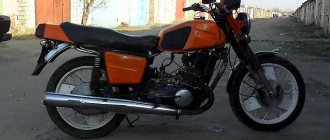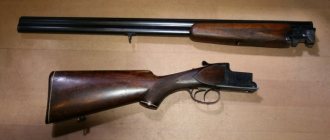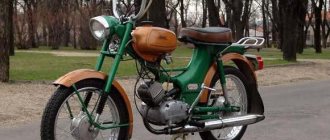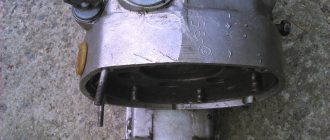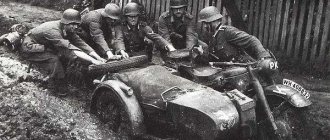It just so happened that all the motorcycles that were produced in our country were, to one degree or another, copies of foreign models. The active development of motor vehicles in the USSR occurred in the post-war period, when the government of our country received documentation and technical equipment as reparations. For example, they began producing the German motorcycle DKW RT 125 in Moscow under the name M1A. It was a great motorcycle - beautiful and reliable. In 1951, by order of the USSR Ministry of Automotive and Tractor Industry, M1A production was transferred from Moscow to Minsk to the Minsk Motorcycle and Bicycle Plant (MMVZ).
Release of M1 series motorcycles
The M1A was produced until 1956, when it was replaced by the modernized M1M model. The easiest way to distinguish the new model is by the different welded front and rear fenders, which received sunsets - a characteristic feature of motorcycles of those times. It is thanks to this feature that the M1M looks much more old-school than the M1A.
Like the M1A, the modernized M1M Macaca motorcycle was a single-seater. There was a trunk above the rear fender, on which, however, homemade seats were often installed. But the motorcycle had difficulty carrying two adults, because it was designed for a maximum of 150 kg.
Models
Mopeds:
- MMVZ-1.101(1995-1998)
- MMVZ-1.102 (2003-2004)
- MMVZ-2.154 (2006—2010)
- M1NSK D 49
Scooters:
- M1NSK TS 49
- M1NSK TM 49
- M1NSK TX 49
Electric scooters:
- M1NSK Upa-Upa 500E
Road bikes:
- Minsk M1A "Moscow" (1951)
- Minsk M1M (1956-1961)
- Minsk M-103 (1962-1964)
- Minsk M-104 (1964-1967)
- Minsk M-105 (1967-1971)
- Minsk M-106 (1971-1973)
- MMVZ-3.111 (1973-1976)
- MMVZ-3.115 (1976—1980)
- MMVZ-3.112 (1980—1995)
- MMVZ-3.113 (C 125)
- MMVZ-3.114 (C4 125)
- MMVZ-3.119 (M 125, M 125X)
- M1NSK C4 200
- M1NSK C4 250
- M1NSK R 250
- M1NSK CX 200
- M1NSK D4 125
Enduro:
- M1NSK X 200
- M1NSK ERX 250
- M1NSK TRX 300i
ATVs:
- M1NSK KD 500
- M1NSK KD 625
- M1NSK KD 625B
- M1NSK KD 500U
Snowmobiles:
- M1NSK NIX 390
Sports motorcycles:
- Minsk M-201K (1956)
- Minsk M-201M (1956) - multi-day competition.
- Minsk ShK-125 (1961) - road racing.
- Minsk M-205 - road-circuit racing.
- Minsk M-213 (1969) - multi-day competition.
- Minsk M-211 (1971)
- MMVZ-3.221 “Cross” - motocross.
- MMVZ-3.216 (1977)
- MMVZ-3.225 (1980) - motocross.
- MMVZ-3.227 (1987-1991) - road racing.
- MMVZ-3.229
- MMVZ-3.232 (5.232) (1993) - trial.
- M1NSK RX 250 – motocross.
- M1NSK RX 450 – motocross.
Small-scale, experimental:
- Minsk M-101 (1961-1962)
- Minsk M-106 "Polaris"
- Minsk M-107 (1969)
- MMVZ-3.1133 “Lux” (1987)
- MMVZ-2.601 “Cadet” (2002)
- MMVZ-2.153 “Grif” (2005)
- MMVZ-2.152 (2007)
- M1NSK StreetFighter Shift Custom
- М1NSK M4 200 Shif Custom
- M1NSK M500 Shif Custom
- M1NSK KD 500U Ministry of Emergency Situations
- M1NSK TRX300i Police
Engine and gearbox
In terms of the design of the engine and gearbox of the M1M Makaka motorcycle, it was not much different from its predecessor. The single-cylinder two-stroke engine had the same displacement of 123 cm3, but thanks to a new K-55 carburetor with a diffuser diameter of 20 mm and a new cylinder head with a higher compression ratio, its power increased from 4.25 to 5 hp. This gave an increase of 5 km/h to the maximum speed (75 km/h versus 70 km/h for the M1A). In addition, the cylinder design now used drilled purge ports with aluminum plugs instead of cast ones. The gearbox remains the same - a manual 3-speed. The clutch is also unchanged - multi-disc in an oil bath. The engine ran on a mixture of low-octane A-66 fuel and motor oil, consuming 3-3.5 liters per 100 km.
GAZ M-1 (Emka, Molotovsky first)
GAZ M-1, known as “Emka” (Molotov’s first) is a car that replaced the outdated GAZ-A model and was mass-produced in 1936 - 1943. The Gorky car was in demand, became the most common passenger car, gained great popularity throughout the country and can rightfully be called a symbol of its era. The total number of GAZ M-1 units produced is 62,888 units.
The Gorky Automobile Plant itself was created in 1929 in the city of Gorkov (until 1932 - Nizhny Novgorod). The direct construction of the plant and the production of its first cars (both cars and trucks) are associated with the participation of the American company Ford, licensed copies of whose cars were produced by the plant (Ford Model A and Model AA).
By the mid-30s, the Gorky Automobile Plant was mass-producing only one passenger model - the GAZ-A, which was an adapted copy of the Ford Model A. Despite the fact that this copy began production in 1933, at that time it was already a very outdated model , requiring significant modifications, optimization and design improvements. But all attempts to modernize GAZ-A were in vain and did not bring the expected results. Modified cars could not be mass produced and included in the plant’s production program, so they were produced in small batches.
The agreement concluded in 1929 between the USSR and Ford Motor provided for our side to receive technical documentation for modern American models of Ford cars within 9 years (from the date of signing this agreement). Taking advantage of this opportunity, GAZ received drawings for the Ford B car, mass-produced by the Ford Motor Company since 1932. It was equipped with a four-cylinder engine. It should be noted that Ford also produced eight-cylinder cars (Ford Model 40 and Model 80), which differed from Model B mainly in power plants. The body of all the listed models was approximately the same. Based on the production capacity of the Gorky Automobile Plant, it was impossible to organize serial production of 8-cylinder cars at that time, so the 4-cylinder Ford B, which we named GAZ M-1, was included in the production program of the enterprise.
A test copy of the GAZ M-1 was released at the beginning of 1934 (in January). By the summer, 2 more copies were released. The very first prototype was practically no different from the American Ford B model. The second two had obvious external differences in the body design.
Emka was not a complete copy of Ford. The Ford B model formed the basis of the Soviet prototype, but the engineers of the GAZ plant contributed and showed professionalism in the development of this model. Thus, the chief designer of the plant, Andrey Lipgart, presented a number of technical requirements for the car. First of all, this is to ensure maximum reliability of the model, increase the strength of all its units and components, improve cross-country ability and repairability. At the same time, the GAZ M-1 was supposed to maintain the same comfort, dynamics, and efficiency of the prototype.
As a result, the final model of the GAZ M-1 was significantly transformed and bore little resemblance to the American Ford B, which was its ancestor. But before the copy was sent into mass production, the plant mastered numerous parts, purchased innovative American equipment, and created new production workshops.
What did Soviet engineers change? First of all, the car engine. It retained its power of 50 hp, but all engine systems were changed in one way or another. This was necessary to do in order to unify the engine as much as possible and ensure the possibility of its mass production in-house, based on the existing production capacity. The motor was assembled according to American drawings, but adjusted for operation in Russia; as a result, it was maximally adapted for mass production at a Soviet plant.
Our engineers have successfully solved a number of problematic issues and shortcomings that exist in the American model. So, in order to eliminate engine vibrations, a special floating suspension on cushions was developed and created. The weak Ford frame, unsuitable for use on our roads, was replaced by a reinforced frame with an X-shaped cross member. The transverse springs were replaced with longitudinal ones, as a result of which the design of the machine's axles was changed. The problem with unreliable shock absorbers was also solved, the steering mechanism and braking system were changed. And small profile tires (on spokes) were replaced with high profile ones on stamped metal wheels. Our designers designed many elements from scratch.
There were also changes in the body design, which became more interesting and aesthetic. Along with its appearance, Emka’s body is more reliable, durable, durable and repairable. Positive changes affected the car interior, ensuring convenience for the driver and passengers. The track and base were also increased.
If we talk about the design of the model’s body, it was very typical for cars of that time. This is an all-metal four-door body. Only the roof beams are made of wood. The doors are mounted on rear hinges. Most specimens are black with a red stripe along the side.
The Emka's interior was excellent, much better than in the GAZ-A, and could even compete with foreign analogues. All panels and seats in the car's interior were covered with wear-resistant high-quality woolen fabric, and the instrument panel was painted with imitation wood. For the convenience of the driver and passengers, an ashtray, a cigarette lighter, and visors for sun protection were provided in the cabin. And the driver's seat has longitudinal adjustment.
The engine in the GAZ M-1 model was a four-cylinder with a volume of 3.3 liters. It was assigned the index GAZ-M. At 2800 rpm, the engine allowed the car to achieve 50 hp. Torque - 167 N*m at 1500 rpm. Thanks to these characteristics, with a weight of 1370 kg, the GAZ M-1 could travel at speeds of up to 100 km/h. Drive is on the rear axle. In this car, based on the previous model produced by the Gorky Plant (GAZ-A), a three-speed gearbox was installed. On the second and third there were axes of constant engagement with a sliding shift clutch. A similar box, after minor modernization, was installed on Pobeda until the 50s.
By the end of the 30s. The GAZ M-1 model was outdated and there was a need to modernize it. First of all, this concerned the car’s engine. To update the car, our engineers again decided to use the help of the Americans. The 6-cylinder Dodge D5 engine was recognized as a suitable model for serial production and operation in the Union, which, although produced since 1928, was constantly modernized and met new requirements. Its liter power was almost 2 times higher than that of the M-1 engine.
Throughout 1937-1938 The Soviet automobile industry purchased all the necessary equipment and documents to create new engines. The resulting drawings were converted to the metric system. And by 1940, mass production of new engines began, which received the GAZ-11 index. Their volume was 3.5 liters (3485 cc) and their power was 76 hp. For that time this was a very high figure. At the same time, the engine operated on available operating materials and was quite unpretentious and reliable. It was this that formed the basis of the engines for ZIM and Pobeda cars.
Emka, suitable for installing a new engine, began to be designated GAZ-11-73 (M-11). In addition to the engine, the M-11 differed from the M-1 in its updated appearance - a modern rounded radiator mask, as well as elongated front springs and more efficient brakes. A front anti-roll bar was installed here, and 2nd-acting hydraulic shock absorbers were introduced. But most of the changes in the Emka design were not reflected in documents, as a result of which their complete list is not reliably known to anyone.
A statement from the car plant's engineers was published in the press about plans to install hydraulic brakes on the updated M-11 car. But they were not in the new version, and they first appeared during the post-war Victory.
Speaking about the modernized Emka (GAZ M-11), it is worth noting that the total number of copies produced was approximately 1,170 vehicles. However, there is no reliable information about exactly what engines were installed on them, as well as what equipment they had, and how it differed from the M-1 model. These issues are especially unclear for cars produced in the post-war period.
The GAZ-11-73 car formed the basis of the modernized all-wheel drive GAZ-61. The cars of this model are mainly army pickups and phaetons, which were widely used at that time by army command personnel. They were distinguished by their reliability and unpretentiousness and were indispensable transport during the Great Patriotic War. Moreover, the GAZ-61-73 is the world’s first comfortable SUV with a closed sedan body.
The GAZ-11-73 model was produced until 1948, and the GAZ-11 engine until 1992. It was installed on tanks during the war years, and on trucks (GAZ-51, GAZ-52, GAZ-63), and for a ZIM passenger car.
Suspension
But the main difference was not the engine upgrade, but completely new wheel suspensions, which significantly increased driving comfort. Instead of a telescopic front suspension, a push-type short-link fork with spring shock absorbers was installed.
The M1A did not have rear suspension. The unevenness of the road was smoothed out only by the spring suspension of the seat. This defect was corrected on the M1M Makaka motorcycle by using a pendulum rear wheel suspension with spring shock absorbers. The suspension was equipped with dampers in which vibrations were damped by dry friction between friction washers.
M1NSK
In 2007, Motovelo became a private enterprise. New street and touring-enduro class models, as well as scooters, ATVs and snowmobiles, are offered that meet modern requirements.
In 2010, a new logo and spelling M1NSK were introduced, echoing the name of the brand’s first motorcycle. Also, today's model designation system was introduced, which meets the established world standard and is easier to understand.
M1NSK designation system:
- C—model code;
- 4 — four-stroke engine;
- 250 - engine displacement.
Today the plant provides a full production cycle and has its own laboratory of new technology with a set of testing equipment.
Another significant milestone in the history of the brand was the Brest-Dushanbe motorcycle rally held in 2013 together with the CSTO on three M1NSK TRX 300 with a total length of 10,000 km.
In 2014, M1NSK received the People's Brand award.
M1NSK is the only mass motorcycle brand on today’s market that has the USSR State Quality Mark.
Electrical equipment
The M1M was the first to use electrical equipment operating on alternating current. Thus, instead of the G-35 direct current generator, the G-37 alternating current generator was installed. Naturally, the headlight had to be modernized. The ignition coil, horn, low and high beam switch, tail light and battery are used from the previous electrical equipment set.
The speedometer is located directly in the headlight housing - a common feature on post-war motorcycles.
Instead of a rear light there is a reflector. They didn’t think much about safety back then.
Links
- [minsk-moto.com Official website of Minsk-Moto]
- [motoprobeg.by Website about motorcycle races on Minsk motorcycles]
- [forum.motovelo.by/viewforum.php?f=2 Forum about Minsk motorcycles]
- [m1nsk-club.ru Russian club M1NSK]
- [mopedmuseum.ru/mmvz.html Moped Museum]
| : Incorrect or missing image | To improve this article it is desirable:
|
Where did the nickname "Macaque" come from?
M1A, and subsequently M1M, received the nickname “Macaque” among the people. Now it’s difficult to determine where this came from, but there are two main versions. The first is related to the peculiar driving position. And the second says that the combination of the letters M and A in the name of the model hints at the word “macaque”. In any case, this nickname stuck firmly to the first Minsk motorcycles and is already inseparable from them.
The M1M Makaka motorcycle ceased production in 1961, when the M103, and subsequently the M104, took its place on the assembly line. The M1M was a good bike. He had his problems and shortcomings. But this did not stop him from becoming the favorite of many Soviet citizens.
Start
After World War II, documentation and equipment from the German DKW plant in Tschopau were exported to the USSR as war reparations.
The production of the DKW RT 125 model began in Moscow under the M1A brand. By order of the Ministry of Automotive and Tractor Industry of the USSR No. 494 dated July 12, 1951, the production of the M1A motorcycle was transferred from Moscow to the Minsk Motorcycle and Bicycle Plant).
M1A became the basis for simple and reliable classic Minsk motorcycle models, the history of which continues to this day.
Repair dimensions of piston pin MMVZ Minsk 125 cm3
| Piston pin | Piston (pin hole) | ||
| Color group | size, mm | Color group | size, mm |
| ∅ 14 -0,0075 | ∅ 14 (+0,005-0,010) | ||
| white | 14,0000 — 13,9975 | white | 14,0050 — 14,0025 |
| white and blue | 14.0025 — 14,0000 | ||
| black | 13,9975 -13,9950 | black | 14,0000 — 13,9975 |
| black and blue | 13,9975 — 13,9950 | ||
| red | 13,9950 — 13,9925 | red | 13.9950 — 13,9925 |
| Red and blue | 13,9925 — 13,9900 | ||
| It is allowed to install pins and pistons in the following configurations: | |||
| finger | piston (pin hole) | ||
| white | white, white and blue, black | ||
| black | white and blue, black, black and blue, red | ||
| red | black and blue, red, red and blue |
